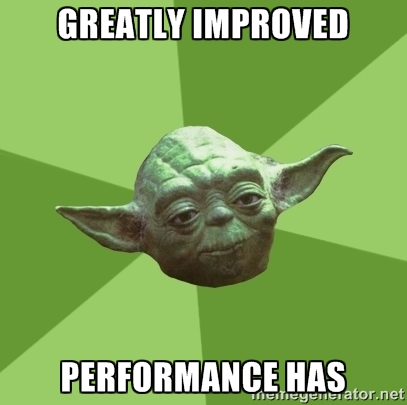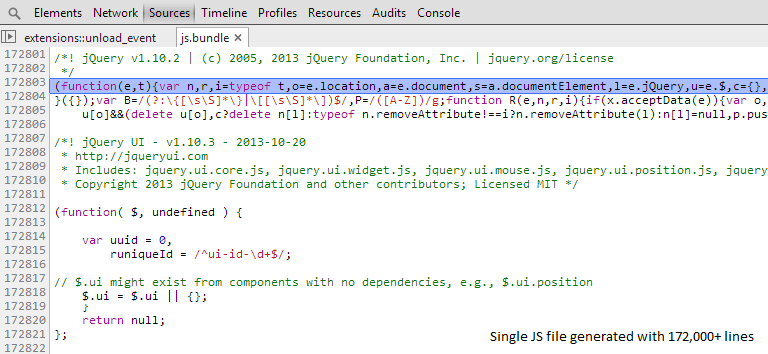Read our latest: The year so far & 1.0 update.

One of the main benefits of BladeRunnerJS is that it analyses your application assets for dependencies so that only the assets that you actually use are served to the web browser. For example, if the index.html of your application looks like this:
<!DOCTYPE html>
<html lang="en">
<head>
<base href="@APP.VERSION@"/>
<title>My Awesome BRJS App</title>
<@css.bundle theme="standard"@/>
</head>
<body>
<@js.bundle@/>
<script>
( function() {
/*** new code ***/
var App = require( 'awesome/App' );
/*** end of new code ***/
var app = new App();
} )();
</script>
</body>
</html>
BRJS detects that the application has a dependency on the JavaScript class defined in awesome/App. If the definition of awesome/App looks as follows:
/*** new code ***/
var WowBladeViewModel = require( 'awesome/amazing/WowBladeViewModel' );
var MegaBladeViewModel = require( 'awesome/fantastic/MegaBladeViewModel' );
/*** end of new code ***/
function App() {
/* App functionality here */
}
module.exports = App;
BRJS can determine that you are using both awesome/amazing/WowBladeViewModel and awesome/fantastic/MegaBladeViewModel through analysing the code and looking for require statements. From here BRJS analyses those Blades for dependencies in the same way. BRJS also looks for any other resources associated with those Blades - CSS, images, HTML templates, i18n, config and so on - and bundles and serves those too.
As stated above, it allows the dev server to only serve the assets that your application actually uses to the client. What's more, the same process is also followed when creating a deployment package for your application.
As you can imagine, analysing dependencies via file parsing, detecting file changes using file-watching, managing a file cache and any other work that BRJS has to perform comes with its challenges. And up until this sprint the performance of the analysis process wasn't good enough.
Here's an image showing the progress we've made for our BladeRunnerJS dashboard load times over the past few weeks.

We're very pleased to have now got things to a much more acceptable level. Work on this hasn't completely finished and we do plan to go back and improve things further in later sprints.
In the What is a Large Scale Complex JavaScript App post we confirmed that a large app will of course have a large codebase. So, when it comes to concatenating the JavaScript in that codebase the resulting file can be very large.
Up until now, BladeRunnerJS would bundle your application JS content in a single file and serve that to the browser to ensure that app load-time during development was as fast as possible. This was much faster than serving individual script files via <script> tags, each resulting a server request. But it also came at a cost - a difficult JavaScript debugging experience...
We've noticed that some web browsers struggle when it comes to debugging very large JavaScript files; they incorrectly report the location of errors, debugger statements and breakpoints. Even Chrome's devtools lose some responsiveness when debugging a large single file. Not to mention it's just generally more difficult to navigate the code when concatenated.

Since this made debugging very difficult, we clearly had to provide a remedy. Now it's possible to get JavaScript files in a number of different ways.
<script> tagsWe're still working out what the defaults should be, but you can configure them for different scenarios by adding attributes to the <@js.bundle@> tags. For example, you may want individual script files when building a single feature (Blade) in isolation in the Workbench, where requesting individual files won't be such a problem. The bundle tag for this looks as follows:
<@js.bundle dev-minifier='none'@/>
The concatentated version when viewing the full application can be configured by setting the dev-minifier attribute to combined as follows:
<@js.bundle dev-minifier='combined'@/>
If you've found a bug that only seems to occur when the full app is running you can of course turn the individual file serving functionality on.
BladeRunnerJS processes the <@js.bundle@/> tag and replaces it with your JavaScript dependencies based on the minifier you have configured (if any). In the case of serving files individually, BRJS analyses dependencies and simply writes <script> tag includes for each one. For concatenation the files are - well - concatenated in the correct order for your app to work.
Here's a simplified example what a typical JsTestDriver config file (jsTestDriver.conf) would look like:
server: http://localhost:4224
basepath: .
load:
# thirdparty libraries
- ../../../../libraries-thirdparty/jasmine/src/jasmine-1.0.1/jasmine.js
- ../../../../libraries-thirdparty/jasmine/src/jasmine/JasmineAdapter.js
- ../../../../libraries-thirdparty/extjs/src/extjs/ext-caplintrader.js
- ../../../../libraries-thirdparty/openajax/src/openajax/OpenAjax.js
- ../../../../libraries-thirdparty/jstd/src/ApiProtector.js
- ../../../../libraries-thirdparty/jstd/src/jstd/mock4js.js
# other sdk libraries
<lots of relative path references>
# your source code
<lots of relative path references>
test:
- tests/**.js
As you can see, including your dependencies explicitly and maintaining such a large list of relative paths is a maintenance nightmare!
One of the great things about the BRJS JsTestDriver plugin is that it uses the same dependency analysis functionality for your tests as it does for the development server or creating deployment packages. It bundles all your dependencies from various locations (SDK libraries, your app libraries, as well as your actual application or module) into a single file. So, you don't have to specify the files you want loaded at test run-time - the JSTD plugin can do that for you.
The JSTD plugin is declared at the top of your jsTestDriver.conf as a path to the plugin jar and it allows you to write/run tests using BRJS and generated HTML and JS bundle files available for the tests at run-time. The exact same jsTestDriver.conf file can go from 100+ lines down to 12-14 lines.
server: http://localhost:4224
basepath: .
plugin:
- name: "BundleInjector"
jar: ../../../../../../sdk/libs/java/testRunner/js-test-driver-bundler-plugin.jar
module: com.caplin.jstestdriver.plugin.CutlassBundleInjectorPlugin
load:
- bundles/js/js.bundle
test:
- tests/**.js
So now, in your test config all you are specifying is the location of where your tests are, a single line. There's no additional maintenance cost in updating this jsTestDriver.conf file as the code you are testing changes it's dependencies.
What's even better is that you don't actually have to care about any of this! BRJS creates a default config file for you that you're unlikely to ever need to change.
As well as building new functionality into BRJS we've been out and about giving a couple of talks. Phil Leggetter was at FOSDEM in Brussels (video coming soon!) and Andy Berry demoed the BRJS workflow at Glasgow.JS.
We're also going to be at QCon London and Fluent in San Francisco in March.
If you want to live on the bleeding edge then you can of course download the source from github. We're working out of a branch called bundler-exploration. The only pre-requisite is the Java 7 JDK and you can get started as follows:
# assuming your running bash on linux or mac
# or cygwin on windows
# get the source from git
git clone git@github.com:BladeRunnerJS/brjs.git
cd brjs
git fetch origin
git checkout -b bundler-exploration origin/bundler-exploration
git submodule init
git submodule update
# build BRJS
./gradlew assemble
# run the dev server
cd cutlass-sdk/workspace/sdk/
./brjs serve
# navigate to http://localhost:7070/ to see the dashboard
If you have any questions, please raise an issue and tag as a question.
We use the term "bundlers" a lot when talking about BRJS. What we mean by this is the 'bundling' (i.e. concatenation) of common resources so that the client only has to make a single request to the server for each asset type. We've talked a bit about the bundling of an application's JavaScript dependencies into a single file in this blog post, but this will also apply for HTML, CSS, I18N and XML content. For more information see the Bundlers documentation.
We're working on implementing the following new asset bundlers which can all share the same BladeRunnerJS model. These include:
The current (legacy) implementations are not compatible with detecting dependencies written in NodeJS/CommonJS style. The work we're doing will allow them to be more efficient when analysing dependencies, share common code and perform smart caching of assets.
Once we have these new bundlers in place, we'll release BladeRunnerJS v0.4. For a view on our plan for BladeRunnerJS 1.0 - please see our roadmap.
We're excited about the BladeRunnerJS v0.4 release. There are a number of ways of keeping track of progress: on this blog, on Twitter, on our Google Plus page, on Github or by subscribing to the BRJS mailing list below: